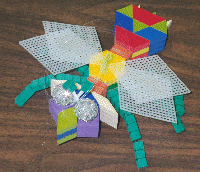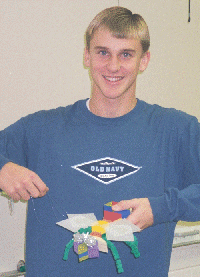I've Got that Geometry Bug!
Jimmy
the Geofly
 It isn’t easy being an insect.
Actually it’s really hard work. It has its fun moments though, especially if
you’re a geofly. A geofly has this strange name for a reason. It’s a fly with a
body completely composed of geometrical shapes. The geofly that I created is
named Jimmy. "Jim the geofly," is what his friends call him. Here is
a description of Jim the geofly, what he faces geometrically throughout the
day, and how he behaves in his environment.
It isn’t easy being an insect.
Actually it’s really hard work. It has its fun moments though, especially if
you’re a geofly. A geofly has this strange name for a reason. It’s a fly with a
body completely composed of geometrical shapes. The geofly that I created is
named Jimmy. "Jim the geofly," is what his friends call him. Here is
a description of Jim the geofly, what he faces geometrically throughout the
day, and how he behaves in his environment.
Jim is completely composed of geometrical shapes as I said before. These
shapes include triangles which have three sides, quadrilaterals which have four
sides, and hexagons which have six sides. Jim’s body contains line symmetry if
viewed from above or from below. This means that if it were cut in half it
would look exactly the same on both sides. The shapes that make up Jim’s body
are that shape for a reason. The abdomen of Jim has a stinger in the back. It
is made up of an acute triangle with a very sharp end. He uses this to scare,
and more importantly, sting his enemies. The top of the abdomen is very
colorful and tells birds observing from above that it is a poisonous insect.
The thorax is the next segment. It is in the six-sided shape of a hexagon. The
sides
 towards the front and the back of
the hexagon join the thorax to the other segments of the insect. The sides of
the hexagon are where the legs are attached. Four legs are connected to the
front sides of the hexagon, and the remaining pair of legs is connected to the
backsides of the hexagon. The angles of the sides on the shape spread out the
legs so that they can better support the insect’s body. The top of the thorax
is a flat surface and that is where the wings of the geofly are connected to
the body. The mandibles of my insect are made of triangles and have a sharp
point at the end of them. The triangles have an acute end exposed that is used
to grab and place food, eaten by the insect, in the mouth. The eyes are spheres.
They are like this so Jim can see in all directions. This helps Jim to find
food and spy his enemies around him. Eyes like Jim’s are called compound eyes.
Jim has a common lifestyle for an insect. He doesn’t live in a colony with
insects like himself. He is an independent and extremely rare insect. Flies
live in the rain forests of South America. They feed on mosquitoes and their
eggs. Geoflies feed on the insects almost all day long. This helps keep the
mosquito population down. If the mosquito population were too large the food
chains that it was involved in would alter in some way. This would throw the
whole balance of life out of whack. That could cause major problems. That is
why Jim and all the geoflies of the Amazon rain forest play an extremely important
role in their environment.
towards the front and the back of
the hexagon join the thorax to the other segments of the insect. The sides of
the hexagon are where the legs are attached. Four legs are connected to the
front sides of the hexagon, and the remaining pair of legs is connected to the
backsides of the hexagon. The angles of the sides on the shape spread out the
legs so that they can better support the insect’s body. The top of the thorax
is a flat surface and that is where the wings of the geofly are connected to
the body. The mandibles of my insect are made of triangles and have a sharp
point at the end of them. The triangles have an acute end exposed that is used
to grab and place food, eaten by the insect, in the mouth. The eyes are spheres.
They are like this so Jim can see in all directions. This helps Jim to find
food and spy his enemies around him. Eyes like Jim’s are called compound eyes.
Jim has a common lifestyle for an insect. He doesn’t live in a colony with
insects like himself. He is an independent and extremely rare insect. Flies
live in the rain forests of South America. They feed on mosquitoes and their
eggs. Geoflies feed on the insects almost all day long. This helps keep the
mosquito population down. If the mosquito population were too large the food
chains that it was involved in would alter in some way. This would throw the
whole balance of life out of whack. That could cause major problems. That is
why Jim and all the geoflies of the Amazon rain forest play an extremely important
role in their environment.
Geoflies face some geometrical challenges in their everyday life. Like all
living things they have to overcome these challenges to stay alive. One
challenge of the geoflies is that their legs are jointed and raise the insect
above the ground. This makes the insect easier to see when it is touching down
on the water. This makes it harder for the geoflies to capture the live
mosquitoes on the water. It overcomes this by moving quickly and staying low to
the surface of the puddles. This adaptation is essential for the hunting
process of geoflies. I have learned a lot in doing this project. I learned that
geometry is everywhere and you just don’t notice it. I also saw how math is
used in everyday life. I had a lot of fun doing this and creating the first
geofly, Jimmy.
Project
Description
Research Questions
Student Work
|